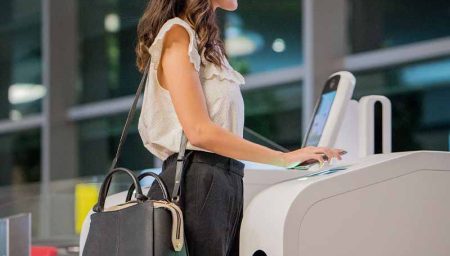Capturing the biometrics of people on the move

Until the beginning of 2020, traveling was something we took for granted. Since the dawn of 2021, borders gradually reopened for business and tourism – in the ‘new normal’, airport technologies factor in contactless biometrics and remote services.
To ensure the safety of travelers and staff, these new airport technologies not only allow to limit interaction, but also help optimize resources and ensure passengers get to their gate faster – without compromising security.
Among the many innovative airport technologies deployed, two stand out the most: remote services and contactless identity verification – both involve cutting-edge biometric technologies. By using remote services, travelers can start their journey from the comfort of their home. For example, they can complete their biometric check-in securely using their smartphone. This requires a state-of-the-art biometric application embedding presentation attack detection to maintain the highest level of assurance for the passenger enrollment process. There is also an increasing interest in contactless biometric technologies to mitigate hygiene concerns and regain the confidence of travelers. Contactless devices used in airports are not just ‘simple touchless technologies – they identify travelers on the move, enabling greater efficiency and a better user experience, while respecting their privacy.
At Lyon‑Saint Exupéry Airport, VINCI Airports launched MONA, the first travel assistant that uses facial recognition technology. VINCI is the first airport operator in the world to offer passengers the opportunity to trial this ground-breaking airport technology – a biometric journey from their home to the plane, via an app downloaded onto their smartphone. Once at the airport, passengers use facial recognition to go through the various check points – from luggage drop to boarding (with the exception of border control) – without any physical contact, simply by showing their face. This is a textbook example of the perfect combination of remote services and contactless technologies to streamline the passenger journey.
Passports are about to be digitalized, so that they can be stored in user’s smartphone – this is called a Digital Travel Credential (DTC). As per the first specifications issued by ICAO in November 2020, a DTC can now be derived from a passport – this can be done by travelers on their own. Provided they have access to a national mobile ID application, all they have to do is to use it to scan the data page of their passport, read the chip, and perform a live selfie to prove their identity. Then they will be able to use their smartphone to identify themselves easily and securely with their DTC, either from home for the check-in, or to breeze through most touchpoints at the airport. Yet, since the DTC is self-derived from home, the ICAO still recommends the authorities to check the physical passport at some point- typically at border control.
Latest News